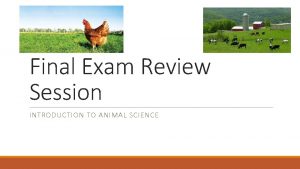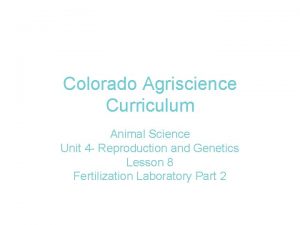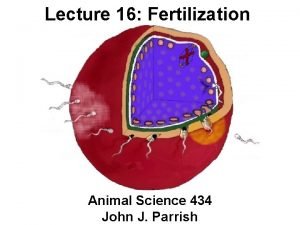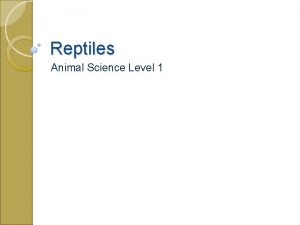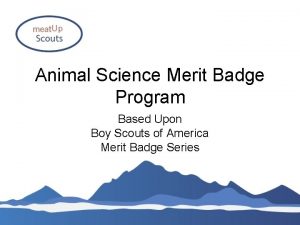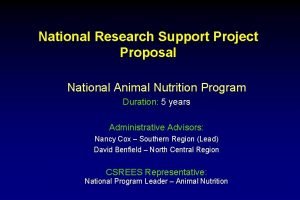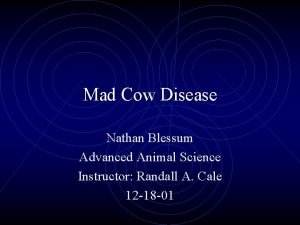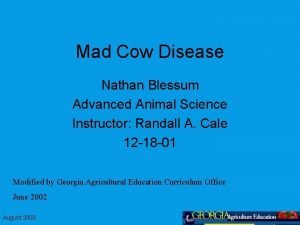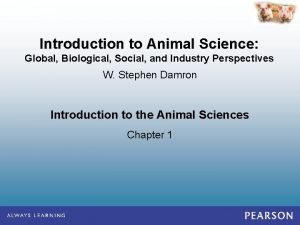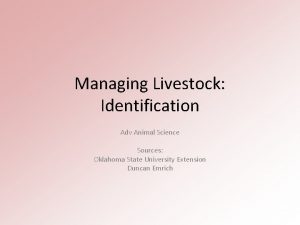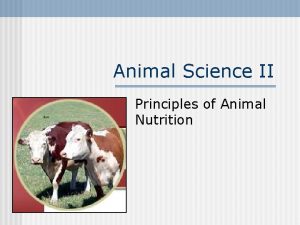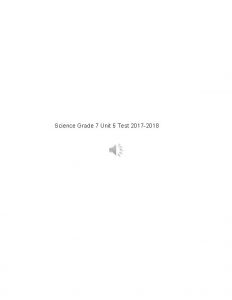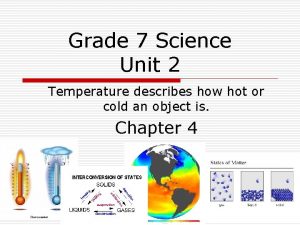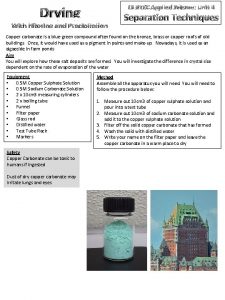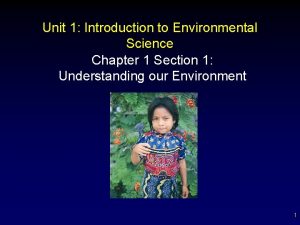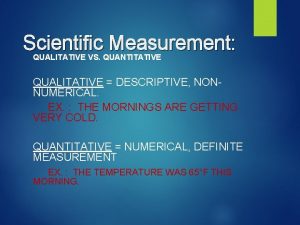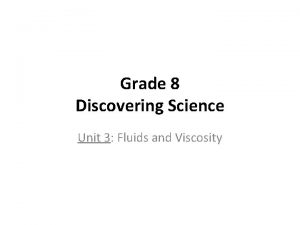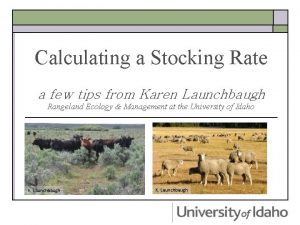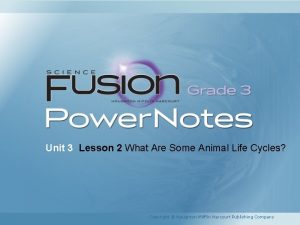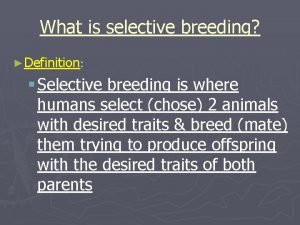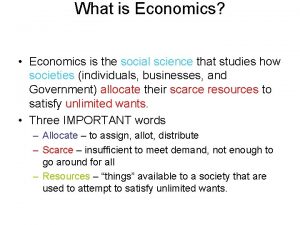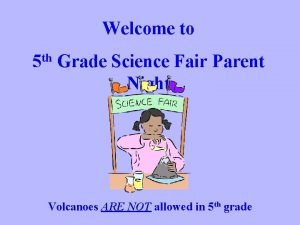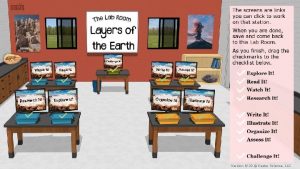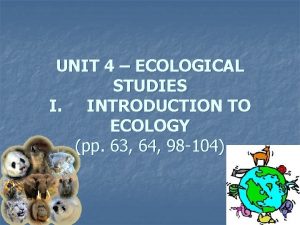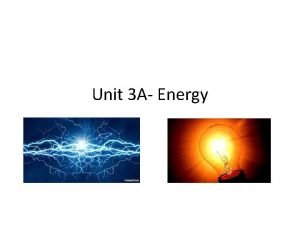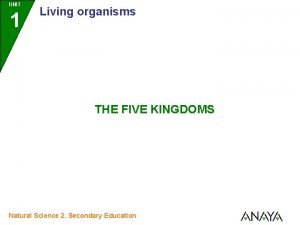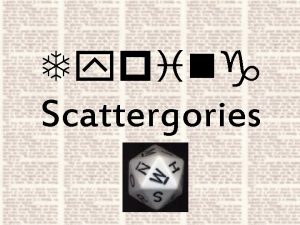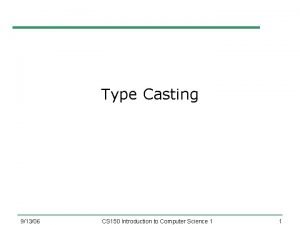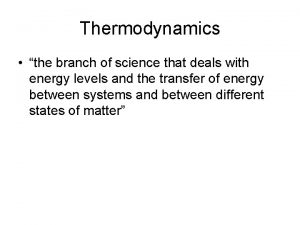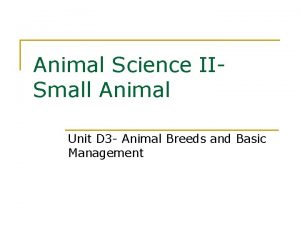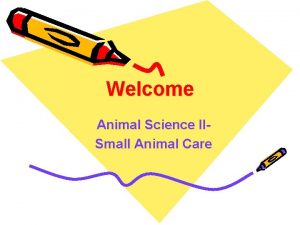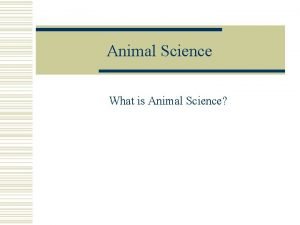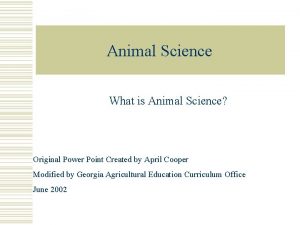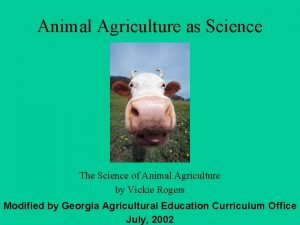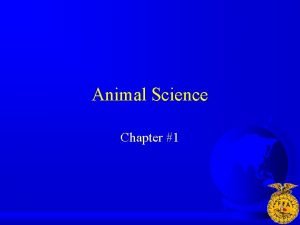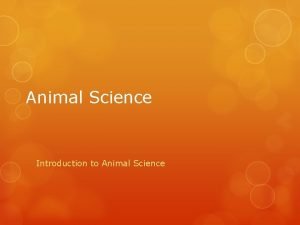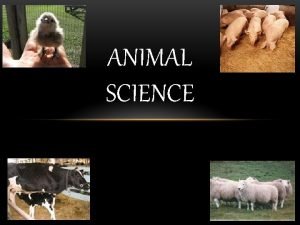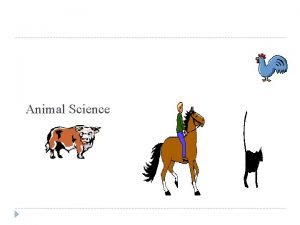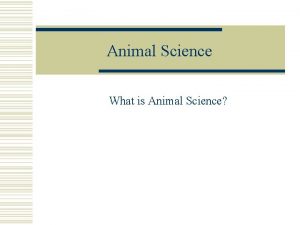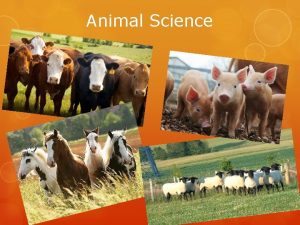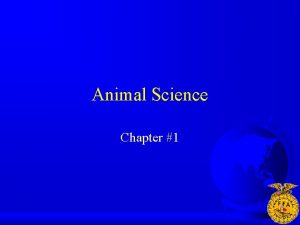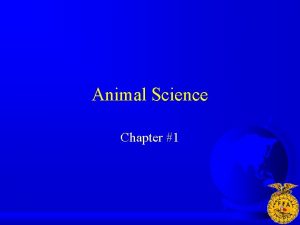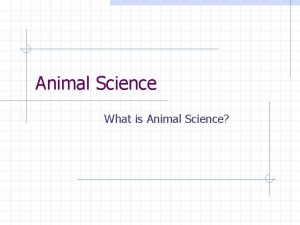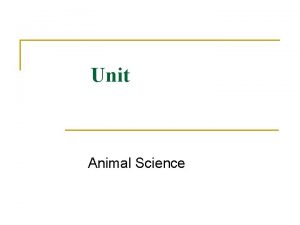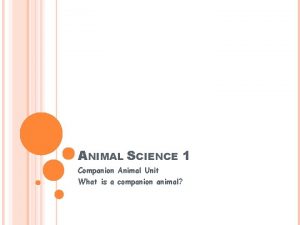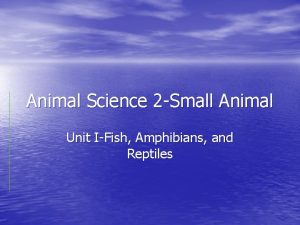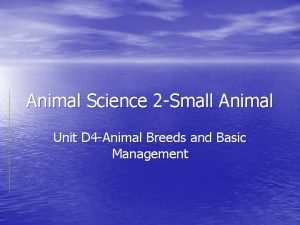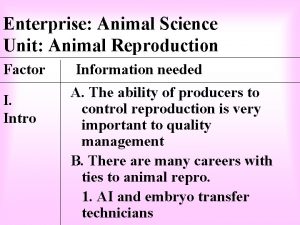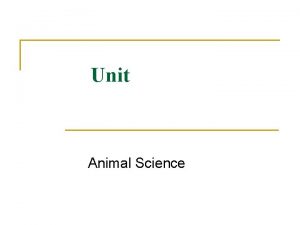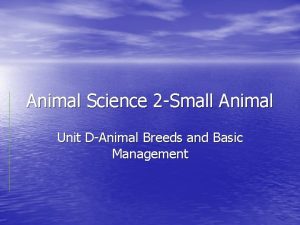Animal Science IISmall Animal Unit D 3 Animal




















































































































- Slides: 116

Animal Science IISmall Animal Unit D 3 - Animal Breeds and Basic Management

Essential Standard 9. 00 n Select the best pocket pet or bird for a given use.

Objective 9. 01 n Discuss major breeds of pocket pets and birds.

Rabbits n n Developed into forty-five recognized breeds Divided into five weight categories 1. 2. 3. 4. 5. Dwarf or Miniature Small Medium Large Giant

Dwarf or Miniature Breeds n n n Britannia Petite Netherland Dwarf Himalayan

Himalayan One of the oldest and widest distributions n Young rabbits are white and slightly tinged with silver-gray n q Matures rabbits become snow white with deep black nose, ears, feet, and tail

Small Breeds n n n Dutch Tan Florida White

Dutch Originated in Holland developed in England n Unique color markings n colored patches on each side of the head that encircle the eyes and ears q rear half is also colored the same as the head q

Florida White n Developed in Florida q n Short and compact q n Crossed with Dutch, Polish, and New Zealand Whites well-rounded hips and hindquarters Bred for a small meat rabbit or a laboratory rabbit

Medium Breeds English Spot n Standard Chinchilla n English Angora n Belgian Hare n Rhinelander n Rex n

English Spot n Introduced to US from England n A unique chair of markings, the size of a pea, run from the base of the ear to the rear flank

Belgian Hare n Originated in Flanders, Belgium n Has a long, fine body, long, straight and slender legs

Rex n Short hair coat, with guard hairs being the same length as the under fur n The fur has a very soft, flush feel

Large Breeds Californian n Cinnamon n American n English Lop n New Zealand n Silver Fox n

Californian Cross of a Himalayan and a Chinchilla and crossed with White New Zealand n White with black colored nose, ears, feet, and tail, and the eyes are red n

English Lop n Oldest domestic rabbit breed known n Body is medium length with well arched back and low head carriage

New Zealand n Leading choice for commercial meat production n White is preferred because the small hairs that remain cannot be seen

Giant Angora n French Lop n Flemish Giant n

Giant Angora n Developed for maximum amount of wool production n Has the body structure of a commercial animal with a unique coat structure

French Lop n Ears are shorter than the English Lop and hang down in a horseshoe shape from the crown approximately 1 ½ inches or more below the muzzle

Flemish Giant n Originated in Belgium n This is the largest of all the domestic rabbit breeds

Pocket Pets n n Not defined by breeds Grouped by colors and/or color patterns

Golden Hamster n Adults reach 5" -6" long q n Rich mahogany or orange color on the back with a white or creamy colored underside q n weigh about 4 ounces A black patch is usually present along the side of the cheeks Long-haired or “teddy bear” hamsters have long, silky fur

Dwarf/small desert Hamster n n Light gray with a dark stripe down the back Smaller than the Golden q n 4" -4 ½" long These are active friendly pets q Due to their smaller size, they are more difficult for children to handle

Gerbils n n n Adult gerbils reach 6"- 8" long nose to tail Weigh 3 – 4 ounces Mongolian Gerbil q reddish brown to dark brown

Rats n Black q q q n tail is longer than the head and body ears are about half as long as the head color is usually black or dark gray with a brown or graywhite underside Brown q q q larger than the black rat tail is always shorter than the head and body thicker and more robust short and more rounded ears fur is dark to gray brown on the back with lighter colors on the underside

Mice n Self colors q n Tans q n any color with tan belly Piebald or pied marked mice q n one color spots, patches or broken patterns Satins q any color or markings with satin coat

Guinea Pig n Adults guinea pigs q q n n reach 8 -14" in length weigh from 1 to 4 pounds. Guinea pigs have very sensitive hearing and can detect frequencies beyond the human ear Self-defense for guinea pigs is to stand on hind legs and chatter with their teeth

Guinea Pig n Types: q Abyssinian n n q American n q hair is short, very glossy and fine in texture Peruvian n n q rough, wiry hair coat the hair is made up of swirls or cowlicks called rosettes longhaired variety that may reach 20"in length since guinea pigs do not have a tail it is difficult to distinguish the front from the back of the Peruvian. It looks like an animated mop Satin n coat is fine, dense, and soft

Chinchillas n Adults range in length from 9 -15 inches q q n Standard q n mutation with black eyes Beige q n blue-gray that is most popular White q n tail of 3 – 10 inches weigh 1 – 2 pounds pearl colored to pastel colored Black q has a black undercoat, very narrow gray-white band, jetblack veil (tips of fur) and high density

Ferrets n Common Sable q q n White q q n ranges from light to dark, depending on the shade of both the underfur and guard hairs the underfur ranges from white to beige red-eyed is referred to as a true albino there a few black-eyed white Sliver Mitt q q underfur of white with guard hairs of black and white gives a silvery appearance

Ferrets n Sterling Silver q n Butterscotch q n similar to Silver Mitt but with more white guard hairs underfur is same as sable but the guard hairs, mask, and hood colorings are butterscotch instead of black Cinnamon q underfur is white or off-white and guard hairs that are rich red-brown or cinnamon color

Rabbit Use n Meat High in protein q Low in cholesterol, fat, sodium q Very palatable q

Rabbit Use n Research q Florida White n q q and laboratory Developed as a small meat and laboratory animal Used to produce disease fighting antibodies Study reproduction Research several human diseases Skin irritation tests n test the reaction of chemicals on the skin

Rabbits- research n Have been used in tests for cosmetics do not have tear ducts q cannot shed tears to dilute chemicals put into their eyes q n Most companies do not use this test anymore

Rabbit Use Fur/wool-divided into four types n Normal 1. n regular rabbit Rex 2. n short Angora 3. n like wool Satin 4. n n n mutation fur smaller in diameter transparent outer shell

Rabbit Use n Compared to sheep’s wool, rabbit’s wool is finer, lighter, warmer, and softer q q n Does not cause irritation to skin Not as scratchy Used in the manufacturing q q q Clothing Toys Coats Hats Gloves

Rabbit Use n Pets q With diversity in size they can fit into different home situations n n n Trainable to use litter box Require little special care Clean, gentle, and lovable pets

Hamsters n n n Used in medical research since 1931 Found that they could be tamed and made into a pet Golden hamster q n most abundant hamster used for research and pets Dwarf/small desert hamsters q q make good pets Children have more problem handling them due to their small size

Gerbils n Japanese scientists were the first to breed in captivity q q easy to work with gentle active during the day have no special food or housing requirements n n drink little water, virtually odorless, and would seldom bite popular pets

Rats n White albino rats q Have been of major importance in medical, biological, and psychological research n used in developing drugs n studying diseases, nutrition, aging, and other topics Intelligent and have the ability to learn so have been used in behavioral studies Colored rats q n q especially have been accepted as pets

Mice n Used for medical and biological research q especially with hereditary studies Pet mice are relatively free of disease n When handled frequently, show little tendency to bite or escape n

Guinea pigs n Bred originally for meat production q n Still used by the native people of Ecuador, Peru and Bolivia as a food source Used for research on pathology, nutrition, genetics, toxicology, and serum development n n Used by Louis Pasteur in his research on rabies Used also as a pet

Chinchillas n Used as a source of fur for thousands of years q q Brought to California from South America to breed for their fur Many furs are sold as a group n n Requires 120 to 150 pelts to make a full-length coat Used as pets since the 1950 s

Ferrets n Recently been found to be wonderful pets q q n have a musky smell and need to be descented males also need to be castrated Used in the 1800 s for rodent control q run into holds and run the rodents out n n n leave a scent behind that would trigger fear Help wire airplanes in hard to reach places Used in scientific research q catch the same colds as humans

Objective 9. 02 n Use care techniques that improve the wellbeing of pocket pets and birds.

Rabbit Housing and Equipment n Hutch size depends on the size of the animal q q small rabbits need cages 24“ wide x 24" long x 14" high large rabbits (over 12 pounds) needing 24" x 48"x 18" high n n The Belgian Hare is an active breed that needs even more space Solid wood floors are needed for large breeds (over 12 pounds) to prevent sore hocks q Absorbent materials for solid floors should be replaced weekly, but cages should be cleaned daily

Rabbit Housing and Equipment n Wire floors are easier to keep clean because urine and feces drop to a removable tray below q n Control urine odor with baking soda sprinkled in the corners of the collection tray q n Cages for small rabbits will need to be cleaned once or twice a week replace absorbent material on a regular basis Raise rabbits outside year-round q q protect from winter wind provide air movement in hot weather if temperature goes above 90°F n A frozen water bottle and fans can help keep the rabbit cool in hot weather

Rabbit Housing and Equipment n Ventilation is a must q n n avoid cool, damp, drafts Sixteen hours of daylight or artificial lighting promotes breeding Galvanized metal self-feeders that clip on the outside of the cage allow quick feeding and help eliminate waste q Bowls take up cage space and are subject to be tipped over

Rabbit Housing and Equipment n Rabbits need a lot of water q q q 16 ounce water bottle is minimum 32 ounce bottle is better Vaccum-type water bottles n n clip on the outside of the cage best for eliminating wet dewlaps and spills that can spoil bedding and result in lack of water for the pet

Feeding Rabbits n Best to use pelleted-type commercial feed formulated to meet daily nutritional needs q q n use fruits, vegetables, and leafy green foods in moderation to avoid gastrointestinal problems Grass hay, oats, corn, oatmeal, wheat germ, pieces of carrot, carrot tops, slices of apples and bananas, pineapple, and green beans are all acceptable Young rabbits q q q should not be fed leafy green vegetables high water content results in diarrhea and dehydration

Hamster Housing and Equipment n Aquariums make good cages. They allow the animal to see out and are easy to clean q q n Water bottle q n needs to hang outside the cage to prevent damage from gnawing or be protected with a metal cover Exercise wheels may be plastic or metal q q n Space for a single hamster is 10" x 16"x 10" tall Cages must be gnaw-proof Commercial cages have stainless steel tops and bottoms Plastic floors are designed so the animal can’t gnaw with their teeth Plastic wheels will be destroyed by the animal’s gnawing, but are quieter This is important because hamsters exercise all night long Clean fresh bedding (paper confetti or strips, wood chips or shavings, hay, straw, or pieces of cotton) q absorb urine and give hamsters something to chew on

Feeding Hamsters Easiest to use commercially prepared hard pellets n Mixed rations should contain seed, lettuce, dried peas, beans and nuts n Avoid sudden changes in the diet q n Don’t leave soft type foods in the cage to spoil q n don’t overfeed greens and fruits that may cause diarrhea be cautious because the feed may get stuck in the hamster’s pouch Special treats include sunflower seeds, crickets, and grasshoppers

Gerbil Housing and Equipment Same as hamsters, but gerbils are more active and need more space q A breeding pair need 150 square inches of floor space q Multiple gerbils need 36 square inches of floor space q Overcrowding can lead to cannabilism. n Gerbils can jump, so a wire mesh cover is essential n Avoid cotton and wool for bedding q can cause blockage in the digestive system n Cardboard tubes from toilet tissue and paper towels make excellent temporary tunnels and gerbils enjoy chewing them up n Only use solid plastic exercise wheels q Wheels that have spokes are may snag the tail of the gerbil and cause injury

Feeding Gerbils n Easiest to use commercially prepared hard pellets q q q Mixed rations should contain seed, corn, oats, wheat, and barley Avoid sudden changes in the diet Don’t overfeed greens (lettuce, cabbage, carrots, turnips, and beets) n n Gerbils like bird seed q q n may cause diarrhea adds variety to their diet feeding oilseed like sunflower may lead to obesity Gerbils do not drink much water, an 8 ounce driptype water bottle is best

Rat Housing and Equipment n Basically the same as gerbils and hamsters q q n Ceramic feed bowls q q n n 10" x 16" x 10" high cage is sufficient for a pair of rats and their litter All equipment needs to be gnaw-proof or protected easy to clean will not rust gnaw-proof difficult to turn over Ropes and ladders are good for exercise and wheels for small rats Prefer paper tissue for nesting q bedding should be wood shavings or chips

Rat Feeding n n n Easiest to use commercially prepared hard pellets for gerbils or other small animals May add dry dog food, fruits, and vegetables Rats consume about 1 ounce of water per day q vitamins and minerals can be added to the water

Mice Housing and Equipment n n A pair of mice need a minimum of 72 square inches of floor space and a height of 8 inches An aquarium 6" x 12" x 8" will work for a pair Bars of cage must be close together (5/16" apart) A mouse condo consist of several layers or platforms built on a table with concealed legs and at least 20" from the floor

Housing and Equipment n n Mice have poor vision and will not jump Wood shavings are ideal bedding q q should be changed at least once per week. Mice urinate in the corners of their cages n n Cat litter and baking soda can help with the strong urine odor Water bowls will not work for mice as they quickly become contaminated with feces and urine

Mice Feeding n Use commercially prepared hard pellets for gerbils or other small animals q q almost anything will work Mice will not overeat

Guinea Pig Housing and Equipment n Single guinea pig needs a 12" x 24" cage in order to get enough exercise q bottom of the cage needs to be at least 3 – 4 inches deep n n n prevent bedding material from being scattered Guinea pigs do not climb and the cage will not need a top Aquariums make excellent cages q wood cages should be avoided because of the urine odor that builds up in the wood

Guinea Pig Housing and Equipment n n When multiple guinea pigs are being kept, each pig will need at least 180 square inches of floor space Keep outside after temperatures warm to 50°F q Provide 3 square feet of run using chicken wire for outside pens

Guinea Pig Feeding n n n Easiest to use commercially prepared hard pellets and feed twice a day Guinea pigs are vegetarians Can not synthesize Vitamin C q q q need Vitamin C enhance pellets to supplement their diet prevent scurvy vitamin C pellets must be used within 30 days of opening

Guinea Pig Feeding n n Fresh greens, lettuce, fruits, herbs, green vegetables, root vegetables, potatoes, clover, and dandelion greens are favorite foods Peanuts and sunflower seed are good treats q may lead to obesity because n n high fat content Guinea pigs drink with their mouth full of feed q q so water bottle tubes must be clean regularly to prevent the build up of bacteria need a 16 or 32 ounce water bottle to meet their needs

Chinchilla Housing and Equipment n Chinchillas are nocturnal q n Metal and wire cages 14" x 24" x 12"will work for a single chinchilla q q n n location that is not too hot (over 90°F will cause heat prostration) Need small mesh wire less than 1" square to prevent loosing small chinchillas Chinchillas must be kept in individual cages q n 24" x 14" is better wood must be on the outside of the wire mesh or it will be destroyed Need adequate ventilation q n need a quiet location during the day they fight and inflict serious injury Polygamous breeding cages q q use a tunnel system for the male to go to different locations females are fitted with a collar that keeps them from using the tunnel

Chinchilla Housing and Equipment n Chinchillas need a bath twice a week q finely ground powder n q q removes excess moisture and oil Powder is placed in a small pan n q n depth of 2 - 3" Leave the pan in the cage for 5 minutes n q volcanic ash available from the pet store allow the chinchilla to roll around in it Chinchillas are not bathed in water During hot weather, baths are needed daily

Chinchilla Feeding n n n Raisins are a favorite treat of chinchillas Pelleted feeds for guinea pigs Feeds made of ground alfalfa hay, corn gluten, wheat germ or bran plus alfalfa hay or timothy hay and green foods like grass, lettuce, leaves, carrots, celery, and fruits

Ferret Housing and Equipment n n n Hutches similar to rabbits Ferrets can be kept outside all year long if protected from inclement weather, kept out of drafts, and shaded in the summer A wood and wire cages 12" x 24" x 10"will work for a ferret with a litter q n will have to be let out for exercise A cage 24" x 14" is better for a ferret pair

Ferret Housing and Equipment n Need larger water bottles q q n n Ferrets are escape artist and doors need to be locked Food bowls need to be heavy earthenware q n like those used by guinea pigs and rabbits 16 or 32 ounce so they will not be turned over Rubber balls, squeak toys, and plastic pipes provide ferrets with tunnels and fun for hours

Ferret Feeding n n n Need a feed containing at least 35% animal protein q Kitten food is higher in protein than cat food A commercial dry food helps maintain gum and teeth health, but plenty of water needs to be available Young ferrets should be fed all they will eat twice a day Add ½ teaspoon of vegetable oil to older ferrets diet q aids in digestion q bowel movement q helps maintain a healthy coat. Treats include: q meat scraps, cracklings, fruits, red licorice, and ice cream in limited amounts

Animal Science IISmall Animal Birds-Unit D 3

Parrot Family n n Contains some of the smartest birds. Many species can be taught to talk, are affectionate, and make excellent pets. Members of the parrot family are known for their large beaks, especially the Macaws. Includes Cockatoos, Cockatiels, Conures, Macaws, Parrots, Parakeets, Lovebirds, Hanging Parakeets

Cockatoos (Parrot Family) n n n Crest or tuft of feathers on the top of the head Ability to mimic words and sounds Intelligent Range in length from 13 -30” Popular birds that make excellent pets Tame easily

Cockatoos (Parrot Family)

Cockatiel (Parrot Family) n n n One of the most popular pet birds About 12” long (the size of a small cockatoo) Commonly found in pet stores at a reasonable price Gray cockatiels are mostly available. Ideal for beginners and youngsters Easy to raise and affectionate

Cockatiel (Parrot Family)

African Gray Parrot (Parrot Family) n n n 13” long Primary color is gray Very alert, intelligent and affectionate Considered to be the best talker of all birds Voice closely resembles a human voice

African Gray Parrot (Parrot Family)

Budgerigar-budgie (Parrot Family) n n n Most popular pet bird in the world Australian bird that gets its name, which means good bird or good food, from the Aborigines About 7” long with a primary color of yellowish-green Can be taught to talk with proper training Easy to care for, inexpensive pet Eats food from floor of cage

Budgerigar-budgie (Parrot Family)

Toucans (Woodpecker Family) n n n Fairly rare as pets May cost $2500 or more Very noisy birds About the size of a macaw Extremely large bill, which can be almost as long as the bird’s body

Toucans (Woodpecker Family)

Perching Birds n n n Largest family of birds Almost 60% of all birds (5, 100 of 9, 000 bird species) Good singers known as song birds

Starlings (Perching Family) n n n Talking Mynah bird is in this group. It is a black bird with an orange bill Has the ability to mimic the human voice and other sounds Require lots of care Cages must be cleaned daily because Mynah birds have a diet of fruit Prices range from $300 to $500

Starlings (Perching Family)

Canary (Perching Family) n n Very important pet Some are bred for their color Others are bred for their singing ability Some are bred to have a crested top (feathering on the top of the head)

Canary (Perching Family)

Finches (Perching Family) n n n Small birds that are sociable in nature Bengalese Finch is the most social of all birds Zebra Finch is the most widely kept and bred finch in captivity.

Finches (Perching Family)

Perches n n Size and style depend on the bird Most store bought cages come with hard plastic perches which may be uncomfortable for birds. q If birds refuse to perch, replace plastic perches with wood perches that are more natural for birds.

Perches n Larger birds like larger perches, smaller birds like smaller perches q q q Finches/canaries- ½” round perch Budgerigars- ½” oval perch Parrots- 1’ square perch

Perches n The perch for large parrot-type birds must be replaced as these birds destroy wood perches. However, the bird exercises its beak and stays busy in the process.

Perches n Limbs and tree branches make natural perches, but care must be taken to insure they are free of mold and pesticide residue.

Perches n Tapered perches work well because they give the bird a choice of most of the comfortable perching spot.

Water and Feed Containers n Water containers need to be hard and easy to clean materials like glass, ceramic, or stainless steel

Water and Feed Containers n Gravity-type waterers that hang outside the cage with a metal spout/tube extending into the cage work excellent.

Water and Feed Containers n Feed containers may be plastic for smaller birds, but parrot-type birds need the same kind of material used for watering containers

Toys n n n Prevent boredom Large parrot-type birds need stainless -steel chains with bells Smaller birds like canaries and finches can have mirrors, chains with bells, and ladders

Cage Location n Location of cage must be out of direct sunlight, free from drafts, in a place of constant temperature, and protected from hazards like poisonous plants and pets.

Feeding n Most birds eat one of three things—seed, fruit, and/or nectar

Seed n The vast majority of birds have a diet of seed q Cereal seeds—higher content of carbohydrates compared to oil n q Canary seed, millet, corn, dehusked oat kernals Oil seeds—higher in fat content than cereal seed and lower in carbohydrates n Sunflower, peanuts, safflower, pine nuts, rape, maw niger, linseed

Seed n Usually bought in a commercial premixed ration of cereal and oil seed that is formulated for certain bird species and provides balance and variety q q Should be dry and free of dust and dirt Moldy seed should never be fed (peanuts are very susceptible)

Seed n May be soaked in warm water for 24 hours for young birds who may have difficulty cracking the seed with their beak or for birds during the breeding and molting season

Soaked Seeds n n n Soaking stimulates germination which causes a chemical change that increases the protein content of the seeds. Before feeding, rinse in tap water and examine for mold or fungi Discard any soaked seeds not consumed within a few hours and clean containers before feeding more soaked seeds

Fruit n n n Consumed by Mynah, lories, and lorikeets Diet does not include seeds, grit, and cuttlefish Soft bill pellets or foods from the pet store Fruit—apple slices, grapes, orange slices, and banana or dried fruit can be fed Mealworms are live food that can be fed also

Nectar n n Nectar and pollen are consumed by lories and lorikeets Powdered nectar is available from a pet store to mix with water

Other Feed Options n n n Green plant material Carrot tops, chickweed, dandelion leaves Kale and spinach in moderation (too much green cause diarrhea) Avoid lettuce because it lacks nutritional value Wash to remove any pesticide residue Feed after it has warmed to room temperature

Other Feed Options n Grit aids in the ventriculus in grinding food up since birds have no teeth q q Soluble-oyster shell breaks down and is a source of minerals Insoluble-crushed granite provides the base for food to rub and work against to be ground up

Other Feed Options n n Cuttlefish bone (marine mollusk) Provides a source of calcium and will readily be eaten by larger birds Smaller birds may need cuttlefish shaved or chipped Particularly useful to female birds who need calcium for egg production

Handling and Training n n n Allow birds to adjust to new locations for 2 to 3 days before any handling is attempted. Offer a treat at regular intervals until it will take the treat through an open door cage Press a stick perch up against the bird’s chest above the legs to encourage the bird to step up on it

Handling and Training n n Once the bird is comfortable one may substitute a finger or hand for the bird to perch on Leather gloves may be needed for larger birds that use their beak to climb to perch

Clipping Wings n n Wings can be clipped to restrict their ability to fly and prevent escape Painless Primary and secondary flight feathers are cut just above the base of the feather shaft Cutting into the feather shaft will result in injury and bleeding

Clipping Wings n The two outer primary flight feathers are left for aesthetic purposes

Teaching to Talk n n Budgerigars, cockatiels, parrots, macaws and cockatoos can be taught to talk Young males are usually the best learners and easiest to teach Remove distractions such as mirrors, toys, and feed during lessons The same person needs to work with a bird on a regular basis. Usually women and children are better trainers.

Teaching to Talk n n n Lessons should be given at the same time everyday. Limit the length to about 15 minutes each day Use short phrases and words and slowly repeat them

Competency 20. 00 Use principles of bird management to create a healthy habitat for pet birds.
 My favourite subject is pe
My favourite subject is pe Unit 6 review questions
Unit 6 review questions Social science vs natural science
Social science vs natural science What are the branches of natural science
What are the branches of natural science Natural and physical science
Natural and physical science Applied science vs pure science
Applied science vs pure science Anthropology vs sociology
Anthropology vs sociology Sciencefusion think central
Sciencefusion think central Why environmental science is an interdisciplinary science
Why environmental science is an interdisciplinary science Windcube
Windcube Hard science and soft science
Hard science and soft science Animal nutrition grade 11
Animal nutrition grade 11 Animal science final exam
Animal science final exam Colorado agriscience curriculum
Colorado agriscience curriculum J
J Reptilenesia animal science
Reptilenesia animal science Animal science career cluster
Animal science career cluster Animal science merit badge worksheet
Animal science merit badge worksheet Animal feed project proposal
Animal feed project proposal Advanced animal science
Advanced animal science Advanced animal science
Advanced animal science Damron introduction to animal science download
Damron introduction to animal science download Adv animal science
Adv animal science Principles of animal science
Principles of animal science Which of the following adaptations helps birds fly
Which of the following adaptations helps birds fly Btec applied science level 3 unit 7
Btec applied science level 3 unit 7 Grade 7 science unit 2
Grade 7 science unit 2 Unit 1 introduction to forensic science
Unit 1 introduction to forensic science Bc science connections 8 download
Bc science connections 8 download Whats aquatic science
Whats aquatic science Unit 6 activity forensic science
Unit 6 activity forensic science Btec level 3 applied science unit 4 assignment b
Btec level 3 applied science unit 4 assignment b Unit 3 career exploration lesson 9 health science
Unit 3 career exploration lesson 9 health science Unit 2 relationship
Unit 2 relationship Types of mixtures
Types of mixtures Unit 4 ap environmental science
Unit 4 ap environmental science Unit 3 health and hygiene
Unit 3 health and hygiene Unit 1 introduction to environmental science
Unit 1 introduction to environmental science Qualitative vs quantitative measurements
Qualitative vs quantitative measurements Grade 8 science unit 4
Grade 8 science unit 4 Example of fluid
Example of fluid Grade 10 science unit 3
Grade 10 science unit 3 Venn diagram plant cell and animal cell
Venn diagram plant cell and animal cell Plant vs animal cell venn diagram
Plant vs animal cell venn diagram Animal rights vs animal welfare
Animal rights vs animal welfare Calculate stocking rate
Calculate stocking rate Unit 26 self evaluation answers
Unit 26 self evaluation answers Lesson 2: animal body plans: 1 biology b unit 3: animals
Lesson 2: animal body plans: 1 biology b unit 3: animals Unit 26 animal anatomy physiology and nutrition
Unit 26 animal anatomy physiology and nutrition Lesson 2: animal body plans: 1 biology b unit 3: animals
Lesson 2: animal body plans: 1 biology b unit 3: animals Surplus keuangan adalah
Surplus keuangan adalah Unit 4 lesson 7 right triangles and trigonometry unit test
Unit 4 lesson 7 right triangles and trigonometry unit test English system conversion
English system conversion Algebra 2 unit 1 test
Algebra 2 unit 1 test Contoh kebutuhan mengitung unit cos unit kerja rekam medis
Contoh kebutuhan mengitung unit cos unit kerja rekam medis Unit process and unit operation
Unit process and unit operation What is unit operation and unit process
What is unit operation and unit process Kerangka konseptual akuntansi pemerintahan
Kerangka konseptual akuntansi pemerintahan Switched on science
Switched on science Work in science definition
Work in science definition Gcse computer science wjec
Gcse computer science wjec Global winds facts
Global winds facts Umass lowell political science
Umass lowell political science A science is considered interdisciplinary when weegy
A science is considered interdisciplinary when weegy Phoenix online computer science university
Phoenix online computer science university Optical illusions science fair projects
Optical illusions science fair projects Selective breeding animals
Selective breeding animals What is size in science
What is size in science Latin word scientia meaning knowledge
Latin word scientia meaning knowledge Fiction
Fiction What is esoteric science
What is esoteric science Energy grade 4
Energy grade 4 Why economics is a social science
Why economics is a social science Space scientific definition
Space scientific definition Rutgers cognitive science
Rutgers cognitive science What is background info
What is background info Variable science definition
Variable science definition Comprehensive science villanova
Comprehensive science villanova How many fields in computer science
How many fields in computer science Jeopardy science questions
Jeopardy science questions Answer the following questions science
Answer the following questions science Science fair abstract examples
Science fair abstract examples Mortuary science internship
Mortuary science internship Ap environmental science exam pass rate
Ap environmental science exam pass rate Elementary science class 5
Elementary science class 5 Ramraj classes nashik
Ramraj classes nashik A pattern of meteorological symbols that represent weather
A pattern of meteorological symbols that represent weather Detector building science olympiad cheat sheet
Detector building science olympiad cheat sheet Wa.portal.cambiumast.com
Wa.portal.cambiumast.com Data science ausbildung wien
Data science ausbildung wien Sola pith forensic
Sola pith forensic Kesler science answer key
Kesler science answer key Experimental variables
Experimental variables Procedural abstraction
Procedural abstraction Unsolved computer problems
Unsolved computer problems Outlook hust
Outlook hust University of bridgeport computer science faculty
University of bridgeport computer science faculty Bridgeport university computer science
Bridgeport university computer science Commensalism in science definition
Commensalism in science definition What is magnetic energy
What is magnetic energy Sequencing apcsp
Sequencing apcsp Example of kingdoms
Example of kingdoms Sqa understanding standards advanced higher computing
Sqa understanding standards advanced higher computing Spike unist internship
Spike unist internship Ucl university computer science
Ucl university computer science Ucl careers service
Ucl careers service Science scattergories
Science scattergories Casting computer science
Casting computer science Predicate computer science
Predicate computer science Mrs gren stands for
Mrs gren stands for Lj wei
Lj wei Tragedy of the commons easter island
Tragedy of the commons easter island Bibliography for science project
Bibliography for science project Life science jeopardy
Life science jeopardy Taxonomy is the branch of science that deals with –
Taxonomy is the branch of science that deals with – One page wonder
One page wonder Institute of industrial science the university of tokyo
Institute of industrial science the university of tokyo












